Saturday, May 3 2025
By Matthieu on Saturday, May 3 2025, 15:12
As we left China, it was an opportunity to update some of these personal "research" documents:
- Etymology of Chinese Characters It proposes and illustrates 3 more sinogram generation mechanism, on the top of the 6 traditional ones. These categories gives effective (and at least non-fictional!) mnemonics to learn Chinese characters.
- Neo Nom 新喃 , initially started as a Japanese-inspired reconstruction of the ancient Vietnamese script Nôm, this document now aggregates many other comparisons between chopstick languages (Vietnamese, Mandarin, Cantonese, Japanese, Korean, etc.) The Neo Nom system is meant to be an etymological markup in interlinear texts, helping readers who know Chinese to get an immediate sense of the etymology of the Vietnamese text. Besides the Nom script, this document also includes phonetic correlations of initial and final consonants, tones, some lexicon lists (false friends, waseikango, homophones, etc.)
- Kunyomi Dictionary, a new study started in 2017. It explores the Japanese indigenous vocabulary with a focus on phonetics rather than kanji, with the goal to give overall correlations between Kunyomi readings (and their offspring developments) and their semantic fields. Rather a work-in-progress proof of concept, looking for similar existing research, because though it's fun to reinvent the wheel, I'd rather travel further on the shoulders of giants.
And here are the other documents, without update:
- KoreoViet 韩越南字 , A Korean-inspired phonetic script for Vietnamese.
- Voc Pro, a vocabulary list for professional context (technical, office) with translations in Vietnamese, Chinese, German, Spanish, and Bahasa.
- Chinese Etymology with Dr. Wieger's book (French), an in-depth etymological introduction, based on the seal script, the Shuowen and critical views of it.
- Waseikango 和制汉语, a list of the Chinese words created by Japanese, Chinese and westerners during the XIXth century to describe new western concept. I’ve compiled the list myself from 2 sources.
- Shuowen 说文解字 , an online XLS copy of the ancient etymological dictionary, with 11,100 entries. I’ve heavily customized it to analyze the text through excel functions and extract data systematically.
Previous version of this list in 2017.
no trackbacks
Friday, June 5 2020
By Matthieu on Friday, June 5 2020, 18:15
This is a graph I made using Gephi to show the number of Duolingo users learning which language from which. Colours represent language families.
English of course stands out as a hub. Duolingo users can learn any language from English, except Catalan and Guarani (from indigenous around Paraguay) which are learned from Spanish. Asymmetric drains are seen towards French, German, Japanese, Korean, and Italian to some extent. The network rather follows geographic proximity, with the notable exception of the Arabic>Swedish stream, accounting for the great effort of migrants to integrate Swedish society.
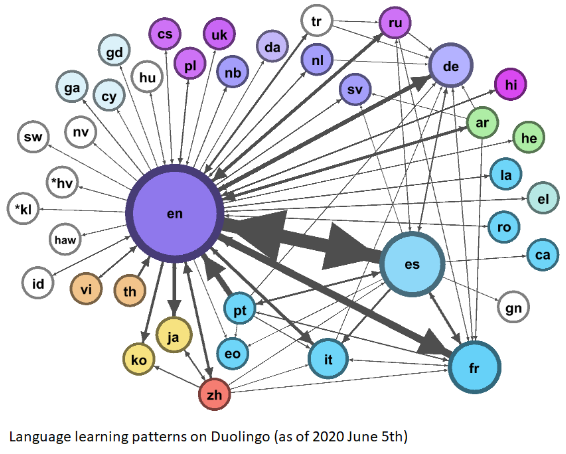
(click on the graph for a bigger picture with explanations)
Data review on June 2021 didn't show much change.
This is an example of semi-structured graph based on a data matrix. The interesting aspect of it is that the shape of the graph emerges from its inner structure, by optimizing the proximity and arrangement of the nodes linked together. Like letting the data spontaneously express itself and grow into a particular pattern.
(Shared here on Facebook Duolingo group)
no trackbacks
Monday, February 3 2020
By Matthieu on Monday, February 3 2020, 19:51
Here is my worksheet about biblical lexicon, a clean compilation of various treasures i've found: Strong concordance lists for Hebrew and Greek with translation counts for KJV and NASV, along with the complete KJV with Strong numbers.
All in all, this allows word counts through the use of excel functions.
Enjoy!

(Click on the picture to open the XLS worksheet)
no trackbacks
Thursday, September 26 2019
By Matthieu on Thursday, September 26 2019, 20:56
Esperanto:
Mi kunhavas chi tie kelkajn datumojn pri la vortorigino de Esperanto. Mi surbazis de la laboro de Andras Rajki el jaro 2006. Li studis grupon de 4000 vortoj kaj serchis la similajn vortojn el la latina, franca, itala, germana, jidisha, nederlanda, angla, rusa, pola kaj lituana lingvoj. Tiuj lingvoj estas konsideritaj tiel "lingvoj de Zamenhofo" char estas la lingvoj kiuj Zamehof pli-malpli kapablis kaj vershajne uzis por krei la internacian lingvon.
Andreas Rajki studas per sia vortprovizo la kompreneblecon inter tiuj lingvoj. Lia samecaj kondichoj estas iom striktaj (priskribitaj chi tie) Ekzemple li jughas ke "perfekta" ne sufiche similas "perfetta", "distanco" ne sufiche al "distanza" aw "distantia", "historio" al "istoria", kaj "havi la "haben", aw "trinki" al "drink". Do oni povus rekalkuli pli grandajn porcentojn de interkomprenebleco se inkluzus tiajn prununcajn variajhojn.
En tiu bilda rezumo ni povas vidi kaj la granda plejparto de Esperanta vortorigino estas la franca kaj latina. Preskaw 80% devenas de la romanaj lingvoj. Sed plej interesa estas ke tiu vortaro tamen tre bone kompreneblas de la parolantoj el la germanaj aw slavaj lingvoj.
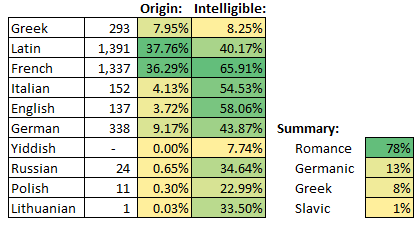
English:
I'm sharing here some information about Esperanto etymology. The work is based on data published by Andra Rajki in 2006. He studied a set of 4000 words for which he looked for similar words from Latin, French, Italian, German, Yidish, Dutch, English, Russian, Polish and Lithuanian. Thos languages are considered "Zamehof languages" since Zamenhof knew them and probably used them to create the International Languages.
Andras Rajki studied the mutual intelligibility between these languages. His similarity conditions are somewhat strict (details here) He decided that "perfekta" wasn't similar enought to "perfetta", "distanco" neither to "distanza" or "distantia", "historio" to "istoria", and "havi to "haben", or "trinki" to "drink". We could then recalculate larger percentages of intelligibility if we'd include those variations of pronunciation.
In the picture we can see that the vast majority of Esperanto vocabulary comes from Latin and French. Nearly 80% come from Romance languages. However it is even more interesting to see that this lexicon is still well intelligible to speakers of Germanic or Slavic languages.
Discussion ici en Français sur l'Atelier
no trackbacks
Tuesday, May 8 2018
By Matthieu on Tuesday, May 8 2018, 09:42
After my first attempt in 2009 to review the modes used in modern jazz, I'm deepening the analysis and including the 72 ragas from southern India.
The diagram shows which of the 12 semitones are used to build the musical scale, with colours indicating their natural consonances or tensions with the starting note.
The excel sheet gives all the data and functions.
Here are the 5 pentatonic modes built without semitone interval:

The pentatonic mode of Re# was used for the melody of this 2011 composition.
The Indian raga KamaVardani was used in the last part of this 2015 composition (Krishna talks!), and in this one (descending little devils..)
Continue reading...
no trackbacks
Monday, May 22 2017
By Matthieu on Monday, May 22 2017, 12:45
Know Thyself!
Direct experience of one's feeling and behavior is best, but some nerdy scientific or pseudo-scientific models of psychology can help putting words on it.
Personality models can be split into 2 categories: those with odd and even numbers of types.
The models with odd numbers (Enneagram, Chinese 5 Agents 五行, 9 Belbin Team Roles, etc.) define the personalities without analyzing them as mere combinations of aspects. They describe each of them as a whole that is more than just a sum of components: these are holistic approaches.
The models in even numbers by contrast are taking analytic approaches: they analyze the personalities as combinations of aspects, based on binary oppositions: Introvert/Extrovert, Active/Passive, Rational/Intuitive, Conservative/Progressive, Indirect/Direct, etc.
Following the tradition of Carl Jung in analytic psychology, the Myers-Briggs Type Indicator (MBTI), takes this analytic approach to a high degree, by defining 4 aspects:
- Extrovert/Introvert: being with others stimulates us, or makes us uncomfortable and exhausted?
- Mode of perception: Sensing/iNtuiting: do we sense the practical facts and objective reality, or do we intuitively get the big picture, and the underlying principles?
- Mode of judgment: Thinking/Feeling: do we decide objectively based on logic and justice, or subjectively with empathy, forgiveness, and aiming at harmony?
- Dominance between the 2 modes: Judging/Perceiving: need for plan and achievement within clear framework and deadlines, or comfortable with improvising in flexible environment?
The combinations of the 4 pairs of letters (E/I, S/N, T/F, J/P) gives the 16 types. Selecting only 3 letters will define a pair of types, and 2 letters defines a group of 4 types (see comments below the diagram)
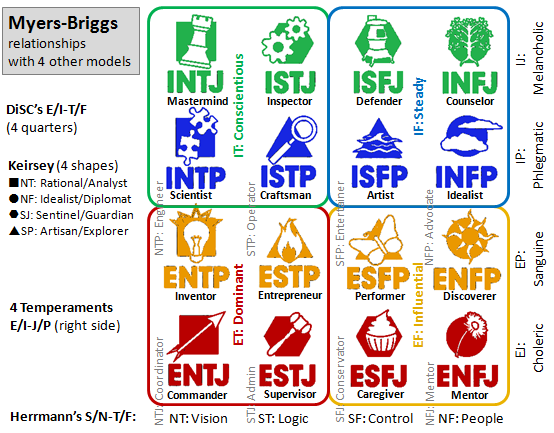
I have tried to integrate into the above MBTI chart 4 other models:
- Herrmann Whole Brain Thinking, which seems to focus on the aspects Thinking/Feeling and Sensing/iNtuiting. Captions at the bottom of diagram, splitting into 4 columns.
- The Greek Four Temperaments, related to my proposal of cardinal cycle, which opposes Introvert/Extrovert, and Stable/Unstable. Captions on the right side of the diagram, splitting into 4 lines.
- DiSC Assessment, which opposes Active/Passive and People/Task. Splitting the above diagram into 4 quarters.
- Keirsey Temperament Sorter, which is often presented in connection with the MBTI. It is represented by 4 shapes, with captions on the left side.
There have been quite many 4-types personality models across history, but matching the types one by one is often too direct. The above diagram uses the wider playground of the MBTI to compare the models more subtly.
So.. what about myself? You can try to classify me as INTP, but also ENTP when in contact with peoples, INFP and INFP when I listen more to my heart (these 4 types form a NP group), and also ISTP and ISFP at time when i get more pragmatic.
no trackbacks
Saturday, April 1 2017
By Matthieu on Saturday, April 1 2017, 23:08
Voici enfin une copie intégrale en PDF de ce dictionnaire plein de révélations, pour 10Mo seulement. Le texte est passé en reconnaissance de caractère et peut donc être recherché par mot-clef avec CTRL+F.
Grandsaignes d'Hauterive, Dictionnaire des Racines des Langues Européennes (1948)
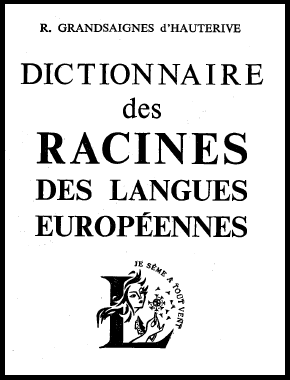
(Cliquez sur l'image pour ouvrir le pdf)
J'avais posté dans cet article un début de résumé de ce dictionnaire.
no trackbacks
Monday, June 13 2016
By Matthieu on Monday, June 13 2016, 17:28
Science Fiction is a broad church, made of many sub-genres. For me it is a wonderful source of inspiration, talking about the future, technology, philosophy, psychology, politics, etc.
In the map below, i've proposed some topics in green. Non-SF but still akin movies are in grey.
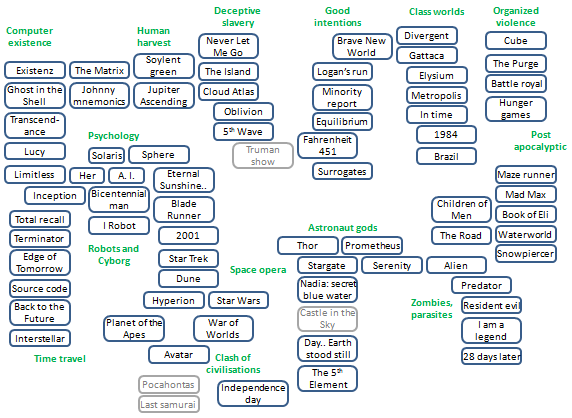
no trackbacks
Sunday, March 27 2016
By Matthieu on Sunday, March 27 2016, 17:12
Here is another working document, compiling Bible quotes by topics. The document also contains a Bible summary chapter by chapter. (so far 886 out of 1239 chapters) I don't guaranty the summary's fidelity, but it can come in handy to give a first overview!

(Click on the picture to open the XLS worksheet)
no trackbacks
Friday, February 5 2016
By Matthieu on Friday, February 5 2016, 04:40
Here is a working document i've prepared, showing major composers (133 so far), ranging from Renaissance until today, on a timeline with their lifetime and key compositions. That helps understanding how their style evolved along with their musical environment.
Click on the image below to open the Excel spreadsheet:
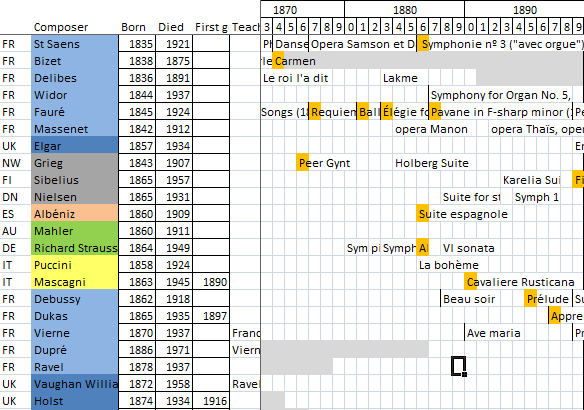
no trackbacks
Friday, November 20 2015
By Matthieu on Friday, November 20 2015, 16:13 - Idées
The recent reading of the Wikipedia article on Jedi (the Star Wars frenzy can spark meaningful thoughts!) has lead me to realize how various fields of teaching and education can complement each others. Jedi are said to be "Polymaths", a word implying the mastery of many fields of knowledge, and at the Renaissance, mastery of arts as well. Since Jedi, like most Asian monastic traditions, blend rather physical training and wisdom, I came out with the following map of education:
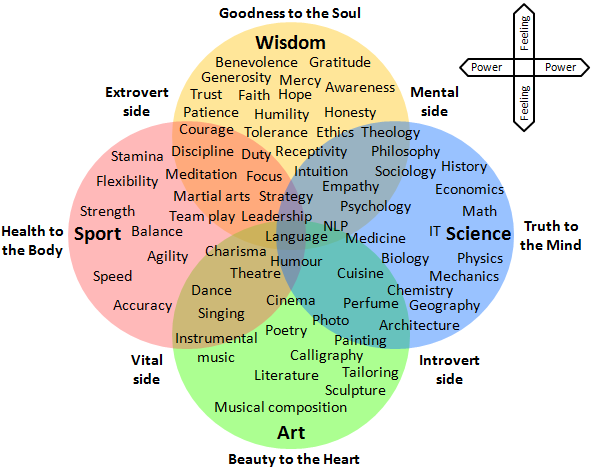
The 4 fields of learning (Sport, Art, Science, Wisdom) are linked to 4 components of the person (Body, Heart, Mind, Soul), and nurture them with 4 types of food or accomplishment (health, beauty, science, peace).
Further, 4 types of historical teaching are proposed, giving emphasis on pairs of fields.
- Sport+Art : Antique education as proposed by Plato
- Art+Science : Renaissance polymath, like Da Vinci
- Science+Wisdom : Medieval scholastic
- Wisdom+Sport : Asian monachism
It is to be noted that back then, the definitions of the 4 fields were not as restrictive as shown here. For instance, Asian monks haven't excluded science but have been including part of it into their wisdoms.
- The horizontal axis is about Power: Can and Know, "Pouvoir et Savoir". By combining horizontally Sport and practical Sciences, we could also imagine another very pragmatic education model: a nation of robots with no emotions (Equilibrium) nor conscience ! (Fahrenheit 451, Brave New World)
- The vertical axis is about Feeling: Conceive and Receive, The combination of Art and Wisdom: people alternating between nerdy passionate creation, and peaceful selfless bounty to one another.
Maybe an accomplished man has to explore and balance all these fields?
I've integrated this map into the broader cardinal cycle.
Facebook post
no trackbacks
Wednesday, July 1 2015
By Matthieu on Wednesday, July 1 2015, 10:17 - Linguistique
My constructed language now explores the possibility of links with the melodies of the Zelda universe, looking for known words and roots, and then extracting new roots to create new words!
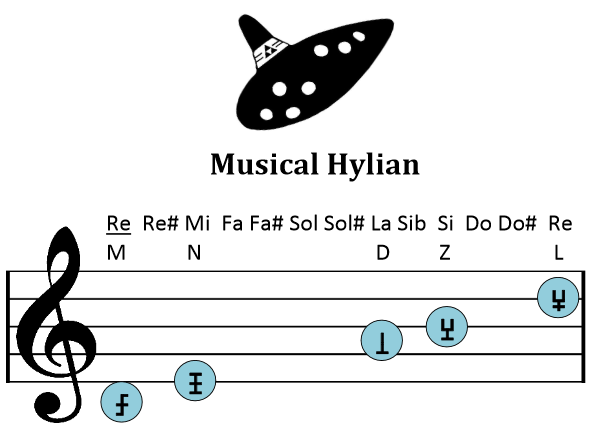
no trackbacks
Wednesday, January 28 2015
By Matthieu on Wednesday, January 28 2015, 11:09 - Idées
I've been thinking for a couple of years how the ideal creation framework could look like. Of course it depends on the type of creation. In my case, I would like to combine and interweave:
- Drawings and paintings representing places, events, characters
- Music, for various places or contexts
- Texts and poems, describing places, stories, feelings
- Cooking recipes, technology descriptions
The main building material would be the drawings, forming full-pages of visual environment. On these drawings there would be some URL links. Some would lead to other connected pages (moving to a nearby area, zooming into a particular region, zooming-out to the upper level), while some others would link to content, such as music or recipes, open in popup windows.
In practice, the universe creation would very simple:
- Upload a full-page drawing.
- Write a text narrative besides it.
- Put tags on it like in facebook, with URL linking to content (mp3, pdf, etc.) or to other pages.
The advantage of such framework is to aggregate the creative content into an interconnected system, that can grow organically from any of its parts! The visitor becomes an explorer who somehow interacts with the universe by choosing where to go and what to look at. It is inspired by the RPG-adventure video game style (Zelda, Final Fantasy, etc.).
Ideally, the framework would also feature comment threads on each page to let the visitors give feedback.
Now, comparing to what is available: Facebook allows to easily upload pictures and very intuitively place tags on it, but only to identify peoples. If those tags could contain any URL, that would do it! But no...
DotClear allows pages in WHTML format with comments, but the width seems limited to the blog page, and placing the tag on the picture would be difficult...
Any other software suggestions to enable this creative boom? Thanks!
no trackbacks
Tuesday, September 2 2014
By Matthieu on Tuesday, September 2 2014, 07:42 - Idées
After quite some time thinking about RDF and semi-structured data, as well as making endless lists of Chinese words and characters, i've come to wish (and vainly looked for it) that some gizmo-App would enable the following:
- Put items on an empty screen surface, in the form of label or boxes (contacts name, Chinese character, words, etc.)
- Draw links between them (affinity, kinship, phonetics, meaning, shape, etc.)
- Let the graph converge and structure itself according to the links
To go further:
- Various types of links could be defined
- Different link attractions could be defined, to give different results depending on priority (e.g. get a graph showing rather friendship than kinship, or rather meaning than phonetics)
Anyone here with the skill, time, and/or passion for this ? Thanks !
Here is what a FOAF graph can look like:
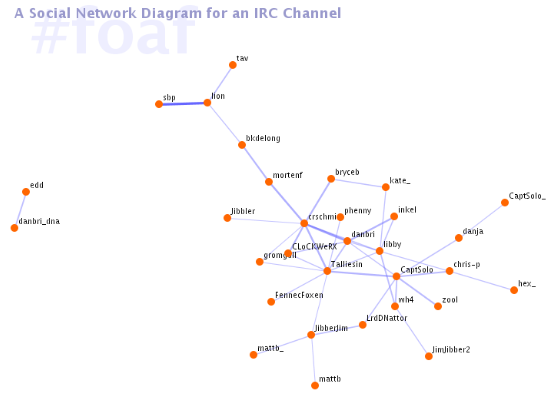
no trackbacks
Sunday, June 15 2014
By Matthieu on Sunday, June 15 2014, 13:21 - Linguistique
More than 15 years ago, I came across a book called "Dictionary of Roots from Proto Indo-European (PIE) Languages". Back then I had been slightly into Greek roots, but not so much into languages as a whole. I much preferred spending time on exotic alphabets, which I believed where more harmonious and easier encompass. Languages, on the contrary, looked like immense and chaotic jungles, calling for a never ending journey... rather discouraging!
In 2006, I've met Esperanto, which became familiar to me within few days (as it would for anyone, that's the beauty of it!). Esperanto has totally changed my perception of grammar and lexicon, in a word, my perception of languages. It exemplified both a methodical construction and a harmonious simplicity. From then, languages have become a fascinating topic: Chinese, Malay, Persian, Arabic, Vietnamese, Sanskrit, Greek, Latin, Hebrew, Japanese, Spanish...
Last year I've suddenly rediscovered this dictionary and how it can wonderfully link words with unexpected connections. Here is a summary of the main PIE roots... I'm slowly preparing it and will update progressively. It's now filled until letter E!
Indo-European Roots
Some remarkable examples of kinship in English:
- Art, harmony, arithmetic, article, arm
- Fate, fable, infant, fame, symphony, profession
- Physics, future, proof, be, build
- Day, joy, divine, journal, Jupiter, Zeus
- Educate, duct, duke, tie, team,
- Police, dictate, index, digit, condition, avenge, attach, teach, take, toe
- Fact, theme, thesis, difficult, factor, artificial, fashion, effect, profit, defect, facility, do, deed
In the provided DOCX document, examples are taken from these languages: Sanskrit, Greek, Latin, French, Spanish, English, German
This Wikipedia article provides a broader spectrum of languages, covering each slice of the big PIE...
http://en.wikipedia.org/wiki/Indo-European_vocabulary
no trackbacks
Friday, April 25 2014
By Matthieu on Friday, April 25 2014, 16:34 - Idées
Revoilà la sympathique frise, depuis 10 minutes avant le Big Bang jusqu’à Lundi dernier, toute une Histoire !
World History Timeline
J'y ai particulièrement détaillé la période préhistorique, et aussi ajouté un résumé en une page... distiller toujours plus, jusqu’au squelette essentiel ! Puis remplumer petit à petit autour...
Pour les dates-clefs, je dirais :
- -500 : Philosophes et fondateurs religieux (Zarathustra, Bouddha, Lao Zi, Socrate)
- -300 : Premiers Empires (Alexandre, Maurya en Inde, Qin en Chine)
- +400 : 1re choc Mongol-Hun (chute de Rome, ruine des Gupta)
- +1200: 2eme choc Mongol (Gengis khan, Tartars, Yuan en Chine, sultanat de Delhi)
- +1500: Fin du Moyen-Age (chute de Constantinople, Amériques, expansion Ottomane, Babar en Inde)
no trackbacks
Tuesday, March 19 2013
By Matthieu on Tuesday, March 19 2013, 15:50
Voici un coffret que j'ai fait confectionner l'année dernière, dans l'idée de rassembler 100 échantillons de parfum dans une petite boîte.

Etant donné que mes souvenirs se fixent particulièrment grâce aux odeurs, ce coffret joue un peu le rôle d'album photo, ou encore de compilation de musique. Il s'utilise comme un catalogue de voyage où l'on peut choisir la destination sous forme de lieu, d'instant, de couleur, d'humeur...
C'est aussi un peu comme un manuel de géographie grâce auquel je révise de temps en temps quelques senteurs exotiques, ou des groupes d'arômes difficiles à distinguer: "Burundi, Rwanda, Ouganda, lequel est plus rond? Plus vif? Plus suave? C'est comment déjà un parfum Chypré? Et poudré? Fougère? Vert?"
Je suis sûr qu'en entraînant régulièrement ses sens à discerner et nommer les choses, on gagne en acuité et largeur de perception; une sorte de supplément d'éveil. Cet entraînement est similaire à l'apprentissage ou approfondissement d'une nouvelle langue, ou encore la découverte de nouveaux concepts, comme une visite sur Wikipédia peut en offrir !
no trackbacks
Saturday, February 18 2012
By Matthieu on Saturday, February 18 2012, 02:05 - Linguistique
J'ai reçu ce matin un mail de mon ami iranien Reza. Comme il y avait un peu de texte en persan, je me suis essayé à le déchiffrer. Cela m'a rappelé un table résumé que j'avais fait il y a quelques années, organisant phonétiquement les lettres du script arabe, ainsi que les lettres ajoutées dans les script farsi (Persan d'Iran, ou Urdu du Pakistan) et jawi (Bahasa de Malaysie).
A toutes fins utiles, le voici !
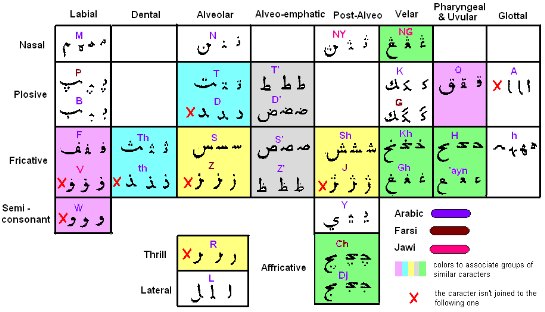
En couleurs sont marqués les groupes se ressemblant visuelement.
Les lettres latines en rose indiquent les caractères introduits par le script jawi: Ny, Ng, V.
Les lettres latines en marron indiquent les caractères introduits par le script farsi: P, Z, J, Ch.
no trackbacks
Sunday, August 28 2011
By Matthieu on Sunday, August 28 2011, 11:02 - Café du commerce
Un an après la première édition, voici une version plus complète de cette firse historique mondiale.
J'y a ajouté une section préhistorique depuis le Big bang, et une ligne détallée pour le Vietnam.
no trackbacks
Thursday, June 2 2011
By Matthieu on Thursday, June 2 2011, 11:18 - Coups de coeur
Cela faisait 4 ans que j'avais pris l'habitude de noter sur un carnet mes "Madeleines de Proust": gazon tondu (Polincove), hortensia mouillé ou piment vert sauce soja (St Pierre), citronnelle mordue (St Pierre), Laurier (St Pierre encore!), peau ensoleillée ou poutre en pin (Grèce), cosse de marron (ND Sannois), nourriture pour poisson (tortue de Floride), livret couleur imprimé neuf (Zelda Majora's Mask), Sel de table (Méditerranée), Romarin (Albigny), bâtiment de ciment frais (garage), lavande (Provence), menthol (ND Belgarde et alchimie), Tilleul (école primaire), encens (Égypte) ...
Depuis que j'ai récemment retrouvé et identifié un parfum d'autrefois, et ça m'a décidé à me lancer un peu plus dans cet univers ! J'ai pris contact avec une professionnelle du parfum sur Hanoi, et on s'est déjà fait quelques exercices de tests en aveugle. J'ai aussi acheté un coffret intitulé "l'encyclopédie du parfum", contenant un jeu de flacon pour apprendre les notes de bases dans la description des fragrances.
Leurs site propose toute une base de donnée des parfums existant depuis le XIXme siècle, avec leurs compositions, familles, facettes, ingrédients, etc... Enfin ! Des mots pour ces couleurs si difficiles à décrire !

Billets connexes:
no trackbacks
Saturday, August 21 2010
By Matthieu on Saturday, August 21 2010, 21:01 - Autre
Juliette m'a rapporté de France ma carte du monde Michelin sur laquelle j'avais déjà bien dessiné et annoté. Elle habille à merveille un grand mur de ma chambre et capte souvent mon attention pour de longue divagations très.. studieuses ! A cette carte familière j'ai eu l'idée d'ajouter une autre moins banale. C'est au musée de Téhéran que j'en avais vu pour la première fois: une frise historique intégrale, mettant en parallèle chaque continent et civilisation ! Plus loin que ça, j'avais dans l'idée de trouver un site internet où l'on pourrait naviguer dans une telle frise en agrandissant tantôt le temps ou l'espace, développant les empires en régions et les dynasties en règnes.
Pour l'instant je n'ai pas trouvé de tel site, mais voici tout de même celui-ci: http://www.hyperhistory.com/online_n2/History_n2/a.html
On y trouve 6 planches de 5 siècles chacune, reliées à de nombreuses petites cartes historiques. Je me suis imprimé ça sur des pages A4 qui, une fois toutes reliées, mesurent plus de 2 mètres ! Je compte maintenant développer la période préhistorique et ajouter les cartes disponibles sur le site.
Voici la version que j'ai imprimée. Elle sera mise à jour à mesure que je l'améliorerai.
no trackbacks
Saturday, April 24 2010
By Matthieu on Saturday, April 24 2010, 18:12 - Musique
Voici un post que j'ai fait sur le forum SquareMusic en 2010:
A l'occasion d'un style de compo en mosaïque, Sakimoto en a profiter pour pousser à l'extrême le jeu des leitmotivs cachés et thèmes habillés en variations diverses.
Comme je suis un malade des tableaux, j'ai rassemblé toutes les occurrences de leitmotivs, par piste et minutage.
La grande devinette, et c'est là que votre aide sera sans doute utile, est de tenter de cerner à quoi/qui chaque leitmotiv fait référence.
J'ai proposé des noms pour commencer...
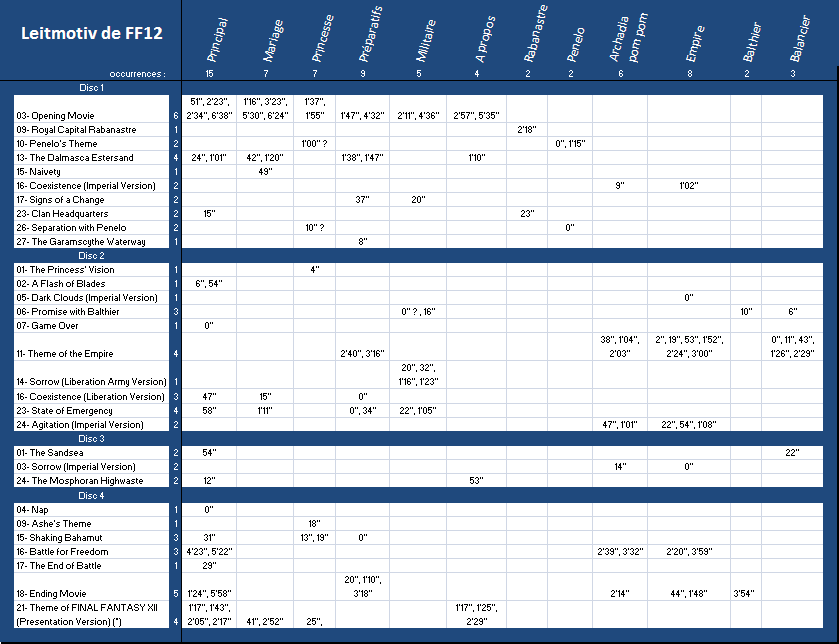
J'avoue que je me suis bien amusé à tendre l'oreille pendant toute l'OST
PS: comme l'image a l'air trop grand pour le blog, la version complète est visible ici.
no trackbacks
Tuesday, July 7 2009
By Matthieu on Tuesday, July 7 2009, 16:28 - Coups de coeur
Un escapade à Clisson m'a fait redécouvrir à quel point je suis un amoureux des parfums naturels, tant pour leur saveur immédiate que pour leur capacité à m'évoquer des souvenirs saisissants. Depuis un an j'ai commencé à faire la liste de ces madeleines de Proust. Au début je les considérais comme des portes olfactives vers des fragments de souvenir, des sortes de vortex spatio-temporels cachés dans les endroits les plus ordinaires, prêt à emporter le voyageur le temps d'une inspiration.
En fait, je vois maintenant que l'action de réminiscence affecte le souvenir exploré. Une première visite dans un coin de souvenir peut se limiter à redécouvrir un fragment d'univers incomplet... que l'on va progressivement reconstruire, par la réflexion de l'historien comme par la rêverie créatrice de l'artiste. A mesure que l'on retourne dans ce fragment de monde, on le construit, l'aménage, le pont qui nous y conduit se consolide.
Non seulement on va développer et construire l'univers du souvenir, mais inévitablement ce "lieu" se trouvera associé au lieu de la réminiscence. J'en fais l'expérience avec l'habitude que j'ai chaque matin de pincer un épi de lavande en arrivant à EDF. Je suis sûr que maintenant ce parfum sera autant connecté à l'univers provençal de mon souvenir qu'au lieu de travail d'EDF. Au final, les parfums sont comme des cordes sur lesquelles on va, volontairement ou non, enfiler des perles de souvenirs. La corde est un fil rouge reliant instantanément ces "lieux" et servant de pont pour les visiter ou les aménager. Ce tissage de souvenirs donne du volume au temps passé, et le fait percevoir comme un vaste ensemble de petits univers au sein duquel les cordes de parfums permettent d'aller partout à partir de n'importe où, et réciproquement.
Billets connexes:
no trackbacks
Sunday, March 29 2009
By Matthieu . on Sunday, March 29 2009, 09:10 - Linguistique
Comment un simple chiffre/lettre appelle un cortège de sensations aussi intenses que décalées...
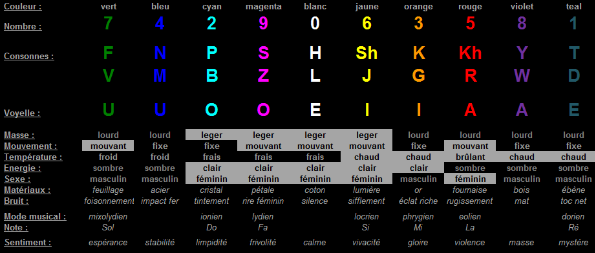
How the reading of numbers and letters give me colorful responses and more...
Continue reading...
no trackbacks
Saturday, March 14 2009
By Matthieu . on Saturday, March 14 2009, 11:31 - Coups de coeur

Nous avons rencontré le dessinateur et peintre, Laurent Parcelier, le 29 décembre 2008 et après quelques chaleureux échanges il nous a donne son accord pour diffuser librement les pdf de ses 8 BD.
Chaque visiteur est même invité à redistribuer à son tour s'il le souhaite. Je vous demande juste de laisser un commentaire ici pour signaler votre téléchargement, et me dire tout le bien que vous en pensez !
La Malédiction des Sept Boules Vertes :
Guilio et le Drôle de Monde :
A partir de ces PDF, je me suis aussi préparé une réédition perso en format A3 ainsi qu'une série en A4 souples.
En images ça donne ça :
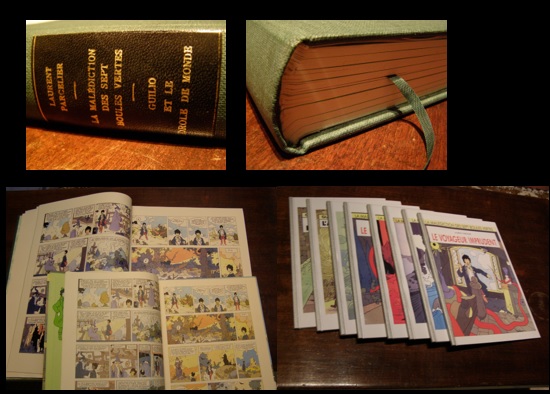
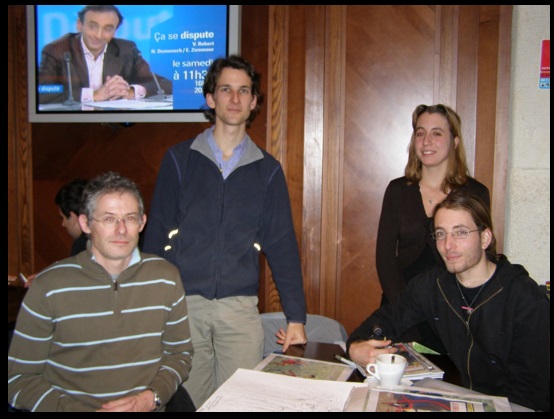
Un groupe Facebook a été créé pour se rassembler et échanger autour de ces BD. Notamment pour s'informer à propos d'occasion de les acheter en vrai !
Voici sa page wikipedia.
Et son site en tant que peintre.
Pour conduire à cette page, vous pouvez utiliser ce lien court: www.notesdevoyage.com/Parcelier
no trackbacks
Tuesday, July 17 2007
By Matthieu . on Tuesday, July 17 2007, 10:36 - Coups de coeur
no trackbacks
Sunday, June 24 2007
By Matthieu . on Sunday, June 24 2007, 01:15 - Café du commerce
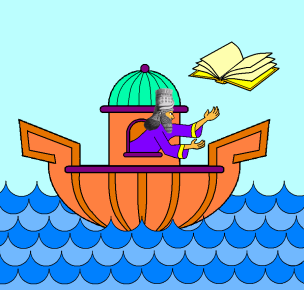
(eh oui, je m'amuse toujours autant avec paint ...)
Et voilà que je me lance dans cette aventure encyclopédique !
"Uta-Napishtim" est un personnage de la mythologie babylonienne, mentionné dans l'épopée de Gilgamesh. Il est l'équivalent du Noé biblique. J'ai choisi ce nom d'utilisateur, car pour moi, cette participation à la Wikipédia est une conséquence naturelle de ce que j'ai appelé le "syndrome de Noé". On pourrait l'expliquer comme ça :
"Soucis de rassembler chez soi tout les médias et fragments de souvenir qui nous sont chers, comme si demain tout pouvait disparaître, emporté par le déluge de l'oubli."
C'est peut être un comportement que j'ai hérité de mon père, et qui s'est manifesté dès le début du lycée, quand j'ai commencé à compiler toute la musique de jeu vidéo trouvable ! (Au bout de 35Go je me suis calmé ;)) J'ai aussi eu de mauvaise frayeurs avec des disques durs qui frôlaient le crash... cela m'a donné l'habitude de sauvegarder régulièrement mes documents, et particulièrement les textes, qui concentrent un maximum d'heure de travail par octet !
En tout cas, j'aime imaginer que Noé, en prévision du Déluge, n'aurait pas seulement sauvé chaque animal mais aussi chaque livre, image et musique du monde ! Une immense médiathèque au milieu des crocodiles cherchant à bouffer le milan qui a déjà bouffé le rossignol  Ce thème du déluge m'intéresse beaucoup depuis un mois, et j'ai imaginé quelques scénarios qui se base dessus. Cela sera sans doute l'occasion d'un article, dans la rubrique "Idées carrément trop géniales"...
Ce thème du déluge m'intéresse beaucoup depuis un mois, et j'ai imaginé quelques scénarios qui se base dessus. Cela sera sans doute l'occasion d'un article, dans la rubrique "Idées carrément trop géniales"...
Pour en revenir à Wikipédia, démarré depuis quelques années, c'est probablement le projet encyclopédique le plus audacieux qui soit, notamment grâce aux nouvelles possibilités d'internet, combinées à une organisation de travail collectif. Y participer est un extraordinaire occasion de se renseigner à fond sur les thèmes qui nous intéressent.
no trackbacks



















 Ce thème du déluge m'intéresse beaucoup depuis un mois, et j'ai imaginé quelques scénarios qui se base dessus. Cela sera sans doute l'occasion d'un article, dans la rubrique "Idées carrément trop géniales"...
Ce thème du déluge m'intéresse beaucoup depuis un mois, et j'ai imaginé quelques scénarios qui se base dessus. Cela sera sans doute l'occasion d'un article, dans la rubrique "Idées carrément trop géniales"...